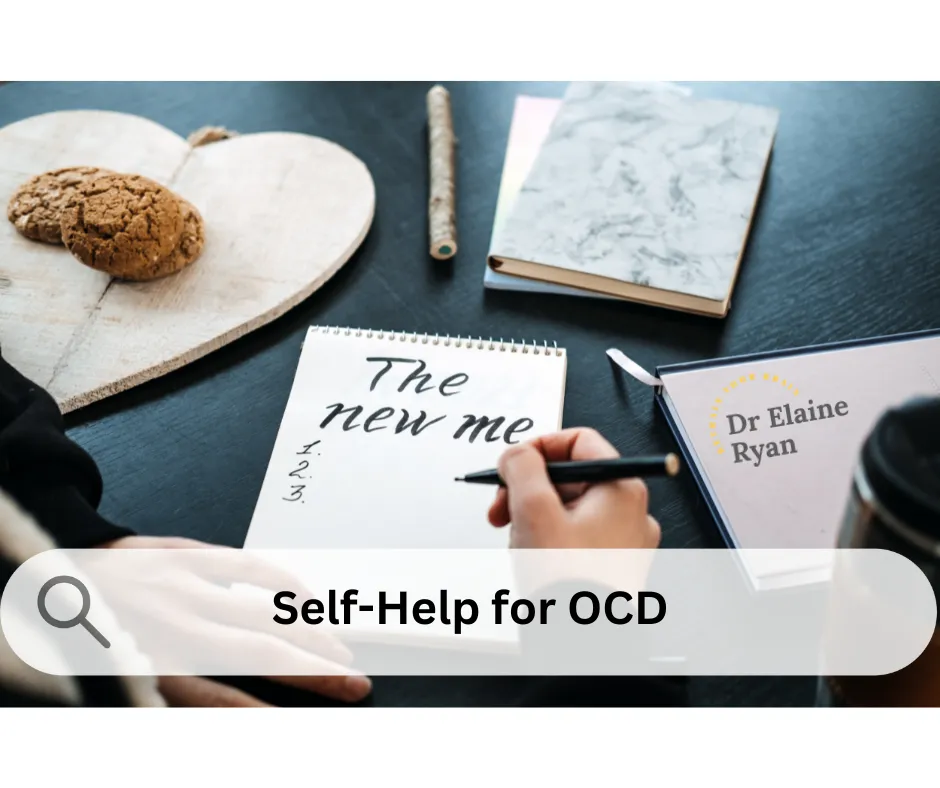Drawing on my 20 years of experience as a psychologist specialising in Obsessive-Compulsive Disorder (OCD), I understand how frustrating it is to read yet another generic list of mindfulness and breathing tips. Below, you’ll find more in-depth strategies—beyond standard CBT—that many of my clients have found helpful. These techniques aim to give you immediate, practical ways to manage intrusive thoughts and compulsions at home, in a more powerful and targeted manner. I’m just going to go straight ahead and list the tips, but if you want more in depth reading, please read the following guides on my site.
- Guide to OCD
- Guide to ERP
- Read more articles on OCD

1. Identify and Name the OCD “Voice”
A key element in self-managing OCD is learning to recognise the disorder’s voice as distinct from your own:
- “Naming the Voice”: Give your OCD an identifiable name or label (e.g., “the Critic,” “the Doubter”). By personifying it, you can separate those intrusive thoughts from your true perspective.
- Immediate Application: When a thought arises—“Did I really lock the door?”—internally respond with, “That’s just the Doubter talking. It doesn’t represent my actual needs.”
Why It Works: Personification strips the obsession of its authority. It becomes easier to see it as “background noise” rather than a factual command you must obey.
2. The “Four Steps” Method (Adapted for Home Use)
Originally described by Dr. Jeffrey Schwartz, the Four Steps are powerful for breaking the obsessive-compulsive cycle without requiring a full CBT framework:
- Re-label: Mentally say, “This is OCD,” when an intrusive thought or urge appears.
- Re-attribute: Remind yourself that it’s not you, it’s the brain sending faulty signals.
- Re-focus: Shift your attention to an alternative action—something absorbing, like a quick chore, reading a page of a book, or doing a short creative task.
- Re-value: Treat the obsessive thought or urge as meaningless noise rather than a genuine concern.
Immediate Application: Tape these steps to your fridge, desk, or phone background. Each time you notice a compulsion creeping in, run through the Four Steps on the spot.
3. Acceptance Rather Than Suppression
Rather than forcing intrusive thoughts away, embrace a stance of non-judgemental acknowledgement:
- “Inviting” the Thought: Instead of avoiding or trying to neutralise the obsession, deliberately spend a short moment greeting it: “Hello, I see you, I’m going to keep going with my day anyway.”
- Micro-Exposure: Let the thought stay briefly, then move on. Avoid prolonged rumination, but also don’t panic and push it away prematurely.
Why It Works: Suppressing a thought often intensifies it. Acceptance reduces the mental tug-of-war, signalling to your brain that the intrusion isn’t genuinely threatening.
4. Advanced Grounding: Sensory Overload Technique
Grounding is more than just naming five items in the room. For severe moments of anxiety:
- Intensify One Sense: For example, hold an ice cube or run cold water on your wrists to create a strong but harmless physical sensation.
- Describe It Aloud: “This is cold. My skin feels tingly. I’m safe; it’s just water.”
- Follow with a Soothing Counterpoint: Once the panic subsides, immediately do something comforting: hold a warm mug of tea or wrap yourself in a soft blanket.
Why It Works: Strong sensory input disrupts spiralling thoughts by forcing your brain to focus on a vivid, present sensation. Pairing it with self-soothing helps you reclaim calm.
Dr Ryan’s Structure Therapy for OCD
These techniques are a great start, but if you want a structured, step-by-step approach to breaking free from OCD, my self-help course provides expert guidance based on CBT and costs €89.
5. Urge Surfing for Compulsions
Often used for addictions, urge surfing can be adapted to OCD:
- Notice the Urge: Pause when you feel compelled to engage in a ritual (e.g., excessive handwashing).
- Visualise the Wave: Imagine the urge as a wave rising and cresting.
- Stay with the Discomfort: Don’t act on it. Watch the wave peak, then fall naturally.
- Check the Aftermath: You’ll likely notice the compulsion subsides on its own within minutes.
Why It Works: Recognising that urges are temporary helps break the link between feeling the compulsion and acting on it. Over time, the intensity of the compulsions decreases.
6. Self-Compassionate Journaling
Go beyond standard journaling by including a structured self-compassion component:
- Situation–Emotion–Self-Kindness:
- Situation: Briefly describe the OCD trigger.
- Emotion: Name the feelings—fear, guilt, doubt—without judgement.
- Self-Kindness Statement: Write a gentle reminder: “I’m allowed to feel anxious. I’m taking steps to manage it. This doesn’t define my worth.”
Why It Works: This method reframes your inner narrative, turning a moment of stress into an opportunity for self-support. You train your mind to respond kindly rather than harshly.
7. Physical Exercise Tweaks
Exercise is frequently recommended, but it’s most beneficial when tailored to OCD:
- Break It Into Micro-Sessions: If anxiety spikes, do a two-minute activity—jumping jacks, dancing, or marching in place. The key is short, intense bursts.
- Pair Movement with Mantras: As you move, repeat a phrase such as “I am strong enough to ride this out.” This combines physical relief with cognitive reassurance.
Why It Works: Quick, repeated movement sessions help interrupt obsessive loops. Paired mantras reinforce emotional resilience.
8. Creating a Personal “OCD Toolkit”
Compile physical and mental tools you can reach for in a crisis:
- Physical Tools: Include items like a stress ball, essential oils for grounding scents, or pre-written notes reminding you of your chosen strategies.
- Mental Tools: List your favourite self-help techniques (like the Four Steps or Urge Surfing) in concise bullet points on your phone or notebook.
Why It Works: Having a ready-made toolkit prevents panic when you’re in the thick of an obsession. You won’t need to scramble for solutions; they’re already at hand.
Final Thoughts
Self-help for OCD can be powerful when it involves more than generic advice. By personalising advanced techniques—naming the OCD voice, practising structured acceptance, using urge surfing, and creating a dedicated toolkit—you can interrupt compulsions more effectively at home. These strategies, drawn from two decades of professional experience, are proven to help shift the balance of power back into your hands.
Dr Ryan’s Structure Therapy for OCD
Want expert-led guidance to help you overcome OCD? My online course provides structured techniques based on my 20+ years of experience treating OCD.
If you find that these self-help methods aren’t providing sufficient relief or if your distress becomes overwhelming, please consult a mental health professional. In many cases, combining targeted self-help with expert guidance accelerates and solidifies progress.
